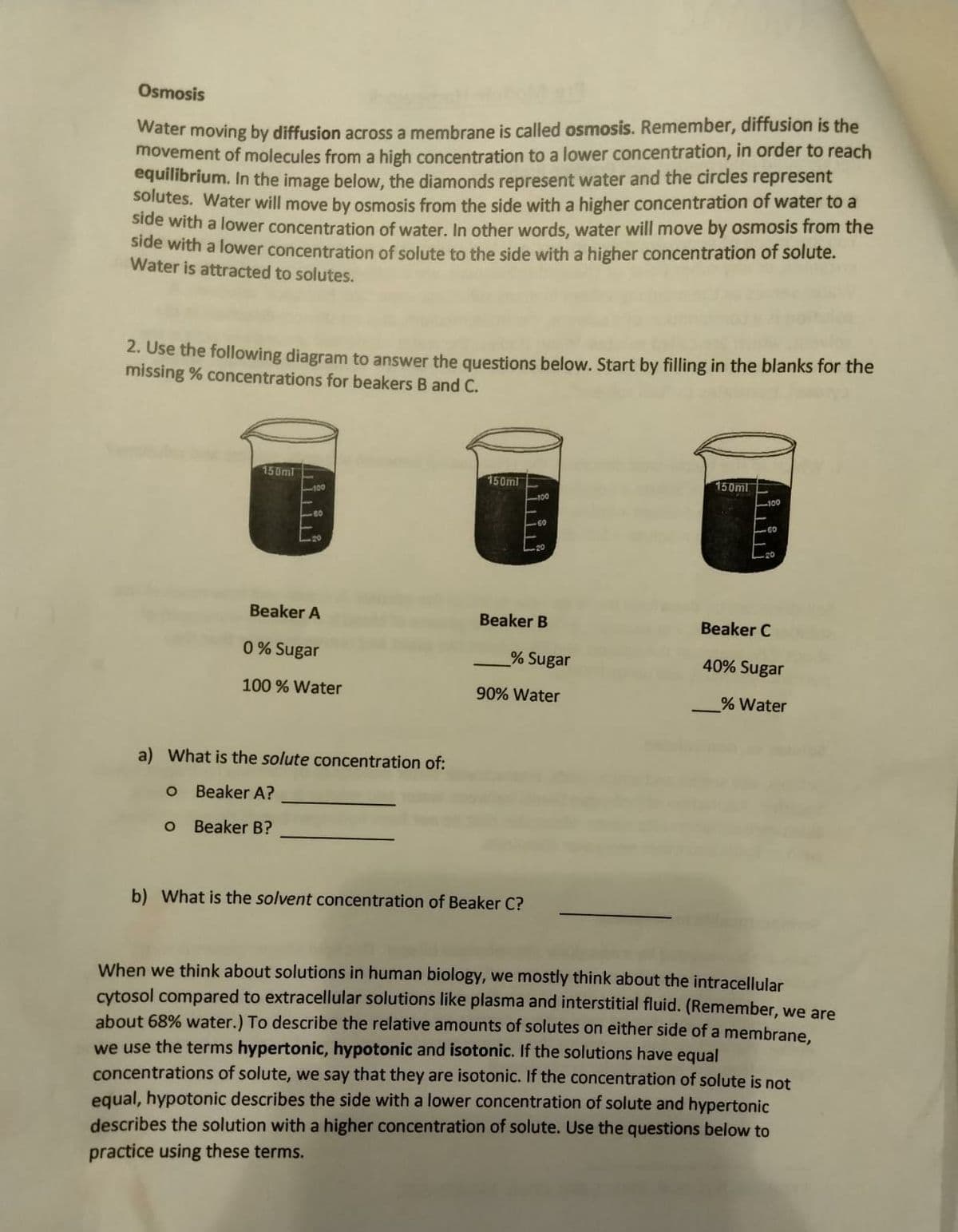2. Use the following diagram to answer the questions below. Start by filling in the blanks for the missing % concentrations for beakers B and C. 150ml 100 Beaker A 0% Sugar 100% Water a) What is the solute concentration of: O Beaker A? o Beaker B? 150ml 100 -60 Beaker B % Sugar b) What is the solvent concentration of Beaker C? 90% Water 150ml 100 18 Beaker C 40% Sugar % Water
2. Use the following diagram to answer the questions below. Start by filling in the blanks for the missing % concentrations for beakers B and C. 150ml 100 Beaker A 0% Sugar 100% Water a) What is the solute concentration of: O Beaker A? o Beaker B? 150ml 100 -60 Beaker B % Sugar b) What is the solvent concentration of Beaker C? 90% Water 150ml 100 18 Beaker C 40% Sugar % Water
Human Physiology: From Cells to Systems (MindTap Course List)
9th Edition
ISBN:9781285866932
Author:Lauralee Sherwood
Publisher:Lauralee Sherwood
Chapter3: The Plasma Membrane And Membrane Potential
Section: Chapter Questions
Problem 6RE
Related questions
Question

Transcribed Image Text:Osmosis
Water moving by diffusion across a membrane is called osmosis. Remember, diffusion is the
movement of molecules from a high concentration to a lower concentration, in order to reach
equilibrium. In the image below, the diamonds represent water and the circles represent
solutes. Water will move by osmosis from the side with a higher concentration of water to a
side with a lower concentration of water. In other words, water will move by osmosis from the
side with a lower concentration of solute to the side with a higher concentration of solute.
Water is attracted to solutes.
2. Use the following diagram to answer the questions below. Start by filling in the blanks for the
missing % concentrations for beakers B and C.
150ml
100
Beaker A
0% Sugar
100% Water
a) What is the solute concentration of:
O Beaker A?
O Beaker B?
150ml
100
Beaker B
% Sugar
90% Water
b) What is the solvent concentration of Beaker C?
150ml
100
Beaker C
40% Sugar
% Water
When we think about solutions in human biology, we mostly think about the intracellular
cytosol compared to extracellular solutions like plasma and interstitial fluid. (Remember, we are
about 68% water.) To describe the relative amounts of solutes on either side of a membrane,
we use the terms hypertonic, hypotonic and isotonic. If the solutions have equal
concentrations of solute, we say that they are isotonic. If the concentration of solute is not
equal, hypotonic describes the side with a lower concentration of solute and hypertonic
describes the solution with a higher concentration of solute. Use the questions below to
practice using these terms.
Expert Solution
This question has been solved!
Explore an expertly crafted, step-by-step solution for a thorough understanding of key concepts.
This is a popular solution!
Trending now
This is a popular solution!
Step by step
Solved in 2 steps

Knowledge Booster
Learn more about
Need a deep-dive on the concept behind this application? Look no further. Learn more about this topic, biology and related others by exploring similar questions and additional content below.Recommended textbooks for you

Human Physiology: From Cells to Systems (MindTap …
Biology
ISBN:
9781285866932
Author:
Lauralee Sherwood
Publisher:
Cengage Learning

Biology: The Unity and Diversity of Life (MindTap…
Biology
ISBN:
9781337408332
Author:
Cecie Starr, Ralph Taggart, Christine Evers, Lisa Starr
Publisher:
Cengage Learning

Human Biology (MindTap Course List)
Biology
ISBN:
9781305112100
Author:
Cecie Starr, Beverly McMillan
Publisher:
Cengage Learning

Human Physiology: From Cells to Systems (MindTap …
Biology
ISBN:
9781285866932
Author:
Lauralee Sherwood
Publisher:
Cengage Learning

Biology: The Unity and Diversity of Life (MindTap…
Biology
ISBN:
9781337408332
Author:
Cecie Starr, Ralph Taggart, Christine Evers, Lisa Starr
Publisher:
Cengage Learning

Human Biology (MindTap Course List)
Biology
ISBN:
9781305112100
Author:
Cecie Starr, Beverly McMillan
Publisher:
Cengage Learning

Concepts of Biology
Biology
ISBN:
9781938168116
Author:
Samantha Fowler, Rebecca Roush, James Wise
Publisher:
OpenStax College

Biology Today and Tomorrow without Physiology (Mi…
Biology
ISBN:
9781305117396
Author:
Cecie Starr, Christine Evers, Lisa Starr
Publisher:
Cengage Learning